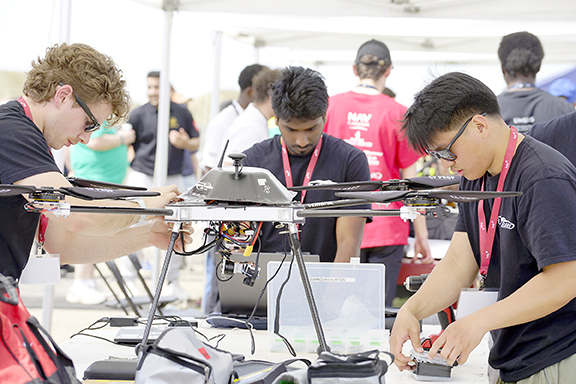Current Temperature
7.2°C
National drone competition descends on Medicine Hat
Posted on May 29, 2025 by Ryan Dahlman Commentator/Courier Photo Submitted by Samantha Johnson. COMPETITION: Members of the Carleton University Blackbird UAV design team preparing their drone for flight.
Commentator/Courier Photo Submitted by Samantha Johnson. COMPETITION: Members of the Carleton University Blackbird UAV design team preparing their drone for flight. By Samantha Johnson
Prairie Rose Public Schools Content Writer
Prairie Rose Public Schools was a hosting partner for the Aerial Evolution Association of Canada’s (AEAC) National Student Unmanned Aircraft Systems (UAS) Competition that started on May 9 and ran through the weekend. Students from 15 universities across Canada arrived in Medicine Hat on Thursday to compete, unloading all their equipment and drones at the South Alberta Collegiate building.
The competition, which has been held for the past 15 years, provides teams with real-world challenges they must address using UAS technology. Teams were responsible for designing and building their own UAS system prototype to demonstrate during the competition and the task for this year was wildfire detection and response. Teams are comprised of students from various academic programs to have the expertise needed to successfully design, construct and operate their UAVs.
2025 marks the first year the competition was held in Western Canada and, with over 170 students competing this year, the first obstacle was transporting the team members and equipment. The Universite de Sherbrooke Miniature Aerial Vehicle team chose to drive their UAV and equipment to Medicine Hat, driving 24 hours on the first day and completing the trip after stopping in Kenora, Ontario for the night.
On Friday, each team gave an oral presentation where they introduced their team, outlined their design process and introduced the UAV’s they would be using to complete the two tasks. On Saturday, the task was wildfire surveillance where the teams needed to find hot spots, simulated by an LED emitter. On Sunday, after all teams were provided with the location of the hot spots, the task was to transport water to each one. The flying was all done at the Len Holden Memorial Airfield, home of the Medicine Hat RC’ers.
The Queen’s Aerospace Design Team’s presentation closed with Jake Campbell explaining to the audience the large number of crashes their fixed-winged UAV, the one they were going to use for the wildfire surveillance, had sustained. The final crash, into a tree, resulted in the drone being destroyed. On Friday of the competition, the team was testing their water-drop UAV, which also crashed and wasn’t repairable, resulting in the team being unable to fly at all.
Campbell, who is entering his final year of electrical engineering at Queen’s University, said, “we spent the year designing two drones, so we had a fixed-wing drone and a few videos of it flying very well. When we initially started testing, our motor was undersized so we weren’t getting enough lift. Our last crash put our airplane into a hundred pieces, it pretty much exploded. No fires or anything, we tried to prepare for that.”
The general consensus was the wildfire surveillance task would be the easier of the two, but this didn’t end up being the case. There were three hot spots in the field, but the teams who did find hot spots only managed to find false ones.
“Our day one survey task proved exceptionally difficult,” said lead judge Katrina Cecco at the award’s banquet. “I never imagined when we were developing this con ops (concept of operations) over the summer as a team that the water bucket transport by drone would be easier than the basic aerial survey for which we gave you very obvious red balloons, visible from the flight line.”
Several teams received awards at the banquet, with the energy in the room celebratory and enthusiastic. The winner of the competition was the University of Waterloo Robotics Group (WARG) who brought three drones to the competition and, in the words of one of the organizers, knocked it out of the park on Sunday by using two drones in sequence to transport water to the hot spots. Many of the teams are reforming after dissolving during the pandemic and WARG is no exception. Started in 1997, they are now in their fifth year as a renewed design team.
Leave a Reply
You must be logged in to post a comment.

